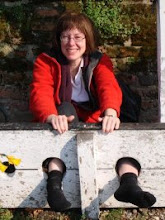 Recently, I have been reading up on Indian quilts. I have had the book on Ralli Quilts for some time, but recently I bought John Gillow's book on Indian textiles and also Crill's book on the V & A collection of Chintz fabrics. I was able to speak to John at the FOQ. He felt that Rosemary Crill at University of East Anglia in Norwich might be a good person to approach.
Recently, I have been reading up on Indian quilts. I have had the book on Ralli Quilts for some time, but recently I bought John Gillow's book on Indian textiles and also Crill's book on the V & A collection of Chintz fabrics. I was able to speak to John at the FOQ. He felt that Rosemary Crill at University of East Anglia in Norwich might be a good person to approach. As you may remember, I discovered that one of my quilts is the one featured in Plate 49 in Hakes book. John felt that the "Himalayan" of the description would be one of the ten hill towns, and that the quilt was probably the product of missionary work. Apparently there was a magazine at the time for Missionary workers, which could be an interesting archive to look at. Another researcher has also found, in the Rose archives in Farnborough, that this quilt came from Muriel Rose's "Little Shop" in London; also that it was dyed blue in order that it photographed more clearly for the plate in Hake's book. I shall have to follow this lead up as well.
As you may remember, I discovered that one of my quilts is the one featured in Plate 49 in Hakes book. John felt that the "Himalayan" of the description would be one of the ten hill towns, and that the quilt was probably the product of missionary work. Apparently there was a magazine at the time for Missionary workers, which could be an interesting archive to look at. Another researcher has also found, in the Rose archives in Farnborough, that this quilt came from Muriel Rose's "Little Shop" in London; also that it was dyed blue in order that it photographed more clearly for the plate in Hake's book. I shall have to follow this lead up as well.
I do have two Ralli quilts, both purchased very inexpensively. This one is made with commercial cottons in bright colours. It measures about 58 x 80 inches. John Gillow states in his book that "they are most probably the influence of British or more likely American female missionaries in the latter part of the nineteenth century. Many of the patterns, such as flying geese, found on Anglo-American quilts are included in Sindhi patchwork quilts."

The edge has a dog tooth edging. The quilting is a straight running stitch. No provenance on this quilt, of course.

Mostly plain cottons but there are one or two prints. The patchwork is a bit hit or miss...the quilt does not lie flat......

...and the quilt is far from square......
 I have a second Ralli quilt - this one is a bit more elaborate and in more muted colours...it is a long quilt, and this photo shows just one half of the quilt - the seller said that it was vegetable dyed but somehow I doubt it...
I have a second Ralli quilt - this one is a bit more elaborate and in more muted colours...it is a long quilt, and this photo shows just one half of the quilt - the seller said that it was vegetable dyed but somehow I doubt it...
Again, mostly squares and triangles, with some dog tooth edging.

The edge has been repaired in some places and the back is worn - a quilt that has seen use....
 The dog tooth edging is applied, simply made by clipping a long strip at regular intervals and then turning under the edges and securing with a stitch or two. The quilt seems to have been much brighter originally and has faded with use and exposure to the light....this does not look like a vegetable red dye to me...
The dog tooth edging is applied, simply made by clipping a long strip at regular intervals and then turning under the edges and securing with a stitch or two. The quilt seems to have been much brighter originally and has faded with use and exposure to the light....this does not look like a vegetable red dye to me...The next quilt history occasion is the seminar at Gregynog at the end of the month - then I will hope to get to the V & A to look at the Hake archive. I was also pleased to see a small collection of Canadian Red Cross Quilts at our local quilt show at the weekend - and surprised to learn that Jackie Maxwell has recently moved to Woodbridge. She is part of the Canadian Red Cross Quilt Research Group.

Hi! Greetings from Finland! The quilt is fantastic! I love it! IT's so nice to find toher quilters from different countries! :)
ReplyDeleteI wish all these quilts could speak and tell us their stories... I hope you can find out more about it, Pippa, especially about the history of the "Himalayan" quilt.
ReplyDelete